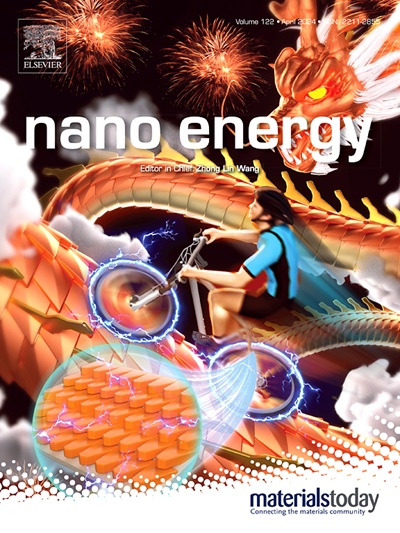Highly active and selective Ag/C catalysts for CO2 electrolysis to CO using 4-aminothiophenol as anchoring agent
IF 16.8
1区 材料科学
Q1 CHEMISTRY, PHYSICAL
引用次数: 0
Abstract
Carbon supported silver nanoparticles (Ag/C) have the potential to reduce the precious metal content in the catalyst layer of carbon dioxide (CO2) electrolyzers producing carbon monoxide (CO), while enhancing the electrochemical performance at the same time. Typically, molecular linkers (e.g. cysteamine) are used to attach the Ag nanoparticles (Ag NPs) to the carbon support. In this study, 4-aminothiophenol (4-ATP) is used for the first time as an alternative anchoring agent, yielding evenly dispersed Ag nanoparticles with an average particle size of 2 nm. Using this linker a current density of 1 A cm-2 was achieved with faradaic efficiency for CO of 85% at 3.3 V. These results were obtained with a low Ag loading of 0.26 mgAg cm-2, yielding a turnover frequency of 9.6 s-1. The catalyst demonstrated high stability during long-term measurements exceeding 200 hours at 500 mA cm-2. The faradaic efficiencies for CO remained consistently around 80% at 3.1 V, with a cell voltage degradation rate of 1.5 mV h-1. This makes thiol-based linkers promising candidates for surface modification to promote durable, efficient and selective electrocatalysts for CO2 electrolysis to CO.

使用 4-aminothiophenol 作为锚定剂的高活性和选择性 Ag/C 催化剂,用于将 CO2 电解为 CO
碳载体纳米银颗粒(Ag/C)具有降低二氧化碳(CO2)电解槽催化剂层中一氧化碳(CO)贵金属含量的潜力,同时还能提高电化学性能。通常情况下,使用分子连接剂(如半胱胺)将银纳米粒子(Ag NPs)连接到碳载体上。在本研究中,首次使用了 4- 氨基苯硫酚(4-ATP)作为替代锚定剂,产生了平均粒径为 2 纳米的均匀分散的银纳米粒子。使用这种连接剂,在 3.3 V 电压下,一氧化碳的电流密度为 1 A cm-2,远红外效率为 85%。这些结果是在 0.26 mgAg cm-2 的低银负载条件下获得的,翻转频率为 9.6 s-1。在 500 mA cm-2 的条件下,催化剂在超过 200 小时的长期测量中表现出很高的稳定性。在 3.1 V 的电压下,一氧化碳的远动效率始终保持在 80% 左右,电池电压衰减率为 1.5 mV h-1。因此,硫醇基连接体有望成为表面改性的候选材料,以促进持久、高效和选择性的二氧化碳电解为一氧化碳的电催化剂。
本文章由计算机程序翻译,如有差异,请以英文原文为准。
求助全文
约1分钟内获得全文
求助全文
来源期刊

Nano Energy
CHEMISTRY, PHYSICAL-NANOSCIENCE & NANOTECHNOLOGY
CiteScore
30.30
自引率
7.40%
发文量
1207
审稿时长
23 days
期刊介绍:
Nano Energy is a multidisciplinary, rapid-publication forum of original peer-reviewed contributions on the science and engineering of nanomaterials and nanodevices used in all forms of energy harvesting, conversion, storage, utilization and policy. Through its mixture of articles, reviews, communications, research news, and information on key developments, Nano Energy provides a comprehensive coverage of this exciting and dynamic field which joins nanoscience and nanotechnology with energy science. The journal is relevant to all those who are interested in nanomaterials solutions to the energy problem.
Nano Energy publishes original experimental and theoretical research on all aspects of energy-related research which utilizes nanomaterials and nanotechnology. Manuscripts of four types are considered: review articles which inform readers of the latest research and advances in energy science; rapid communications which feature exciting research breakthroughs in the field; full-length articles which report comprehensive research developments; and news and opinions which comment on topical issues or express views on the developments in related fields.
 求助内容:
求助内容: 应助结果提醒方式:
应助结果提醒方式:


